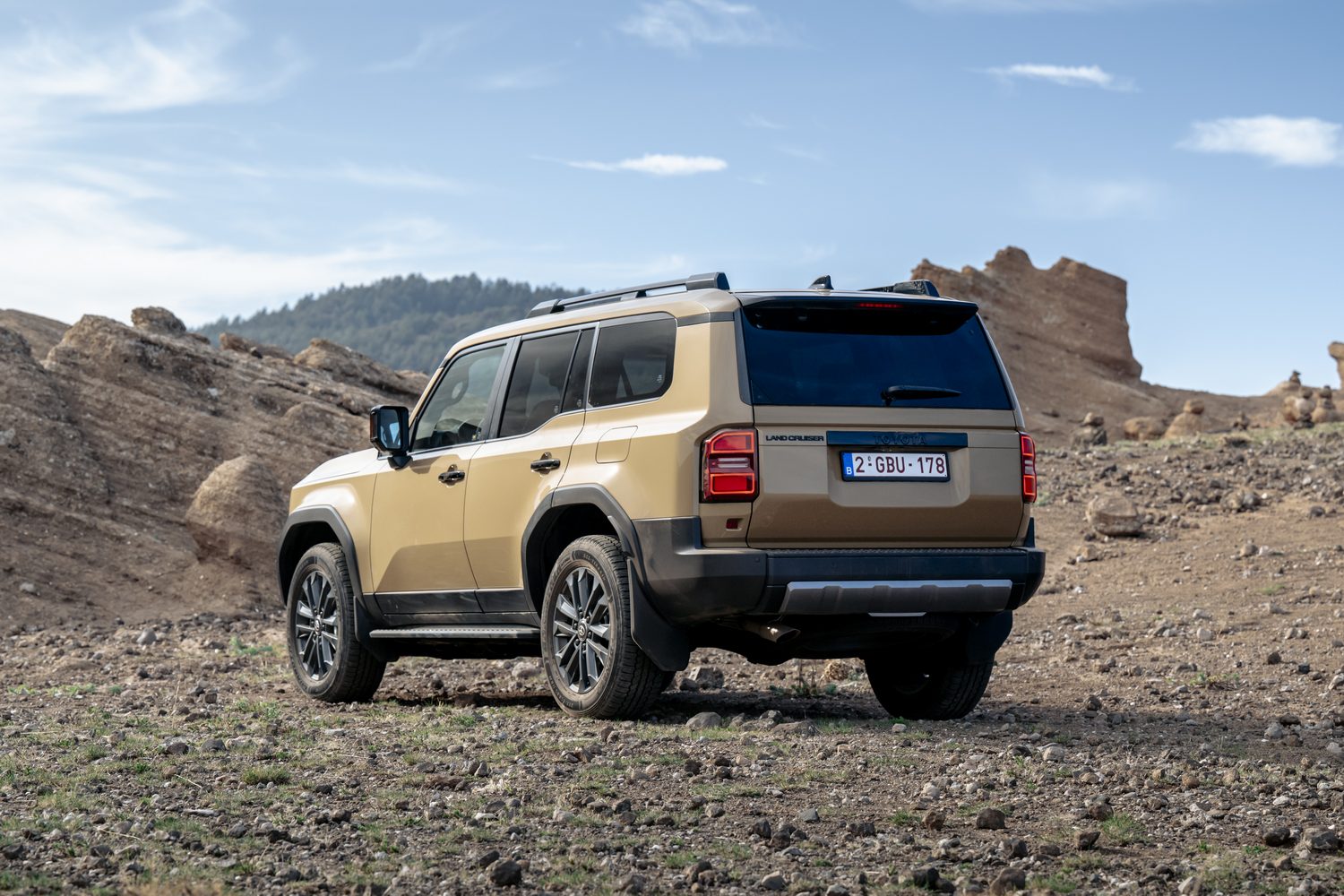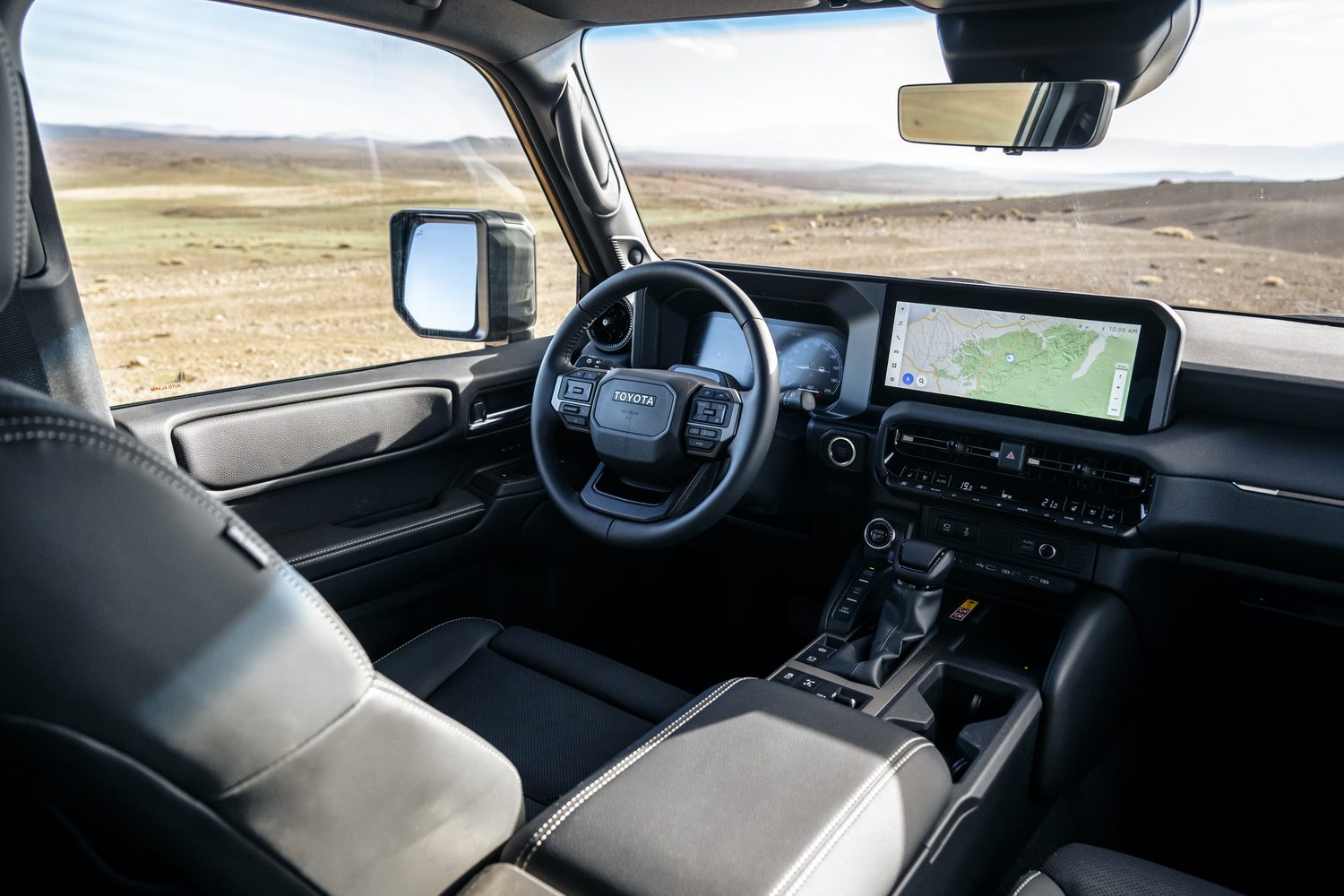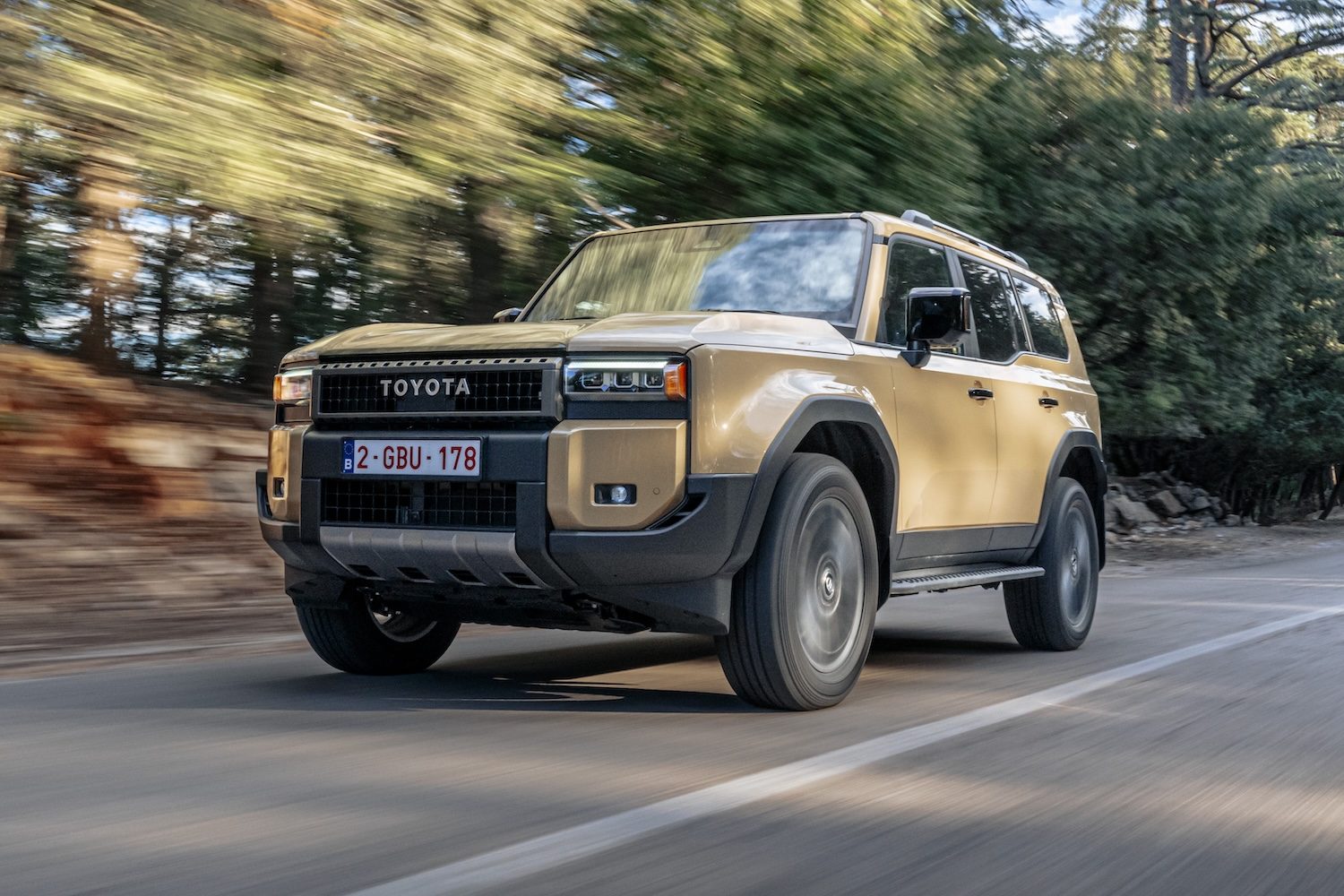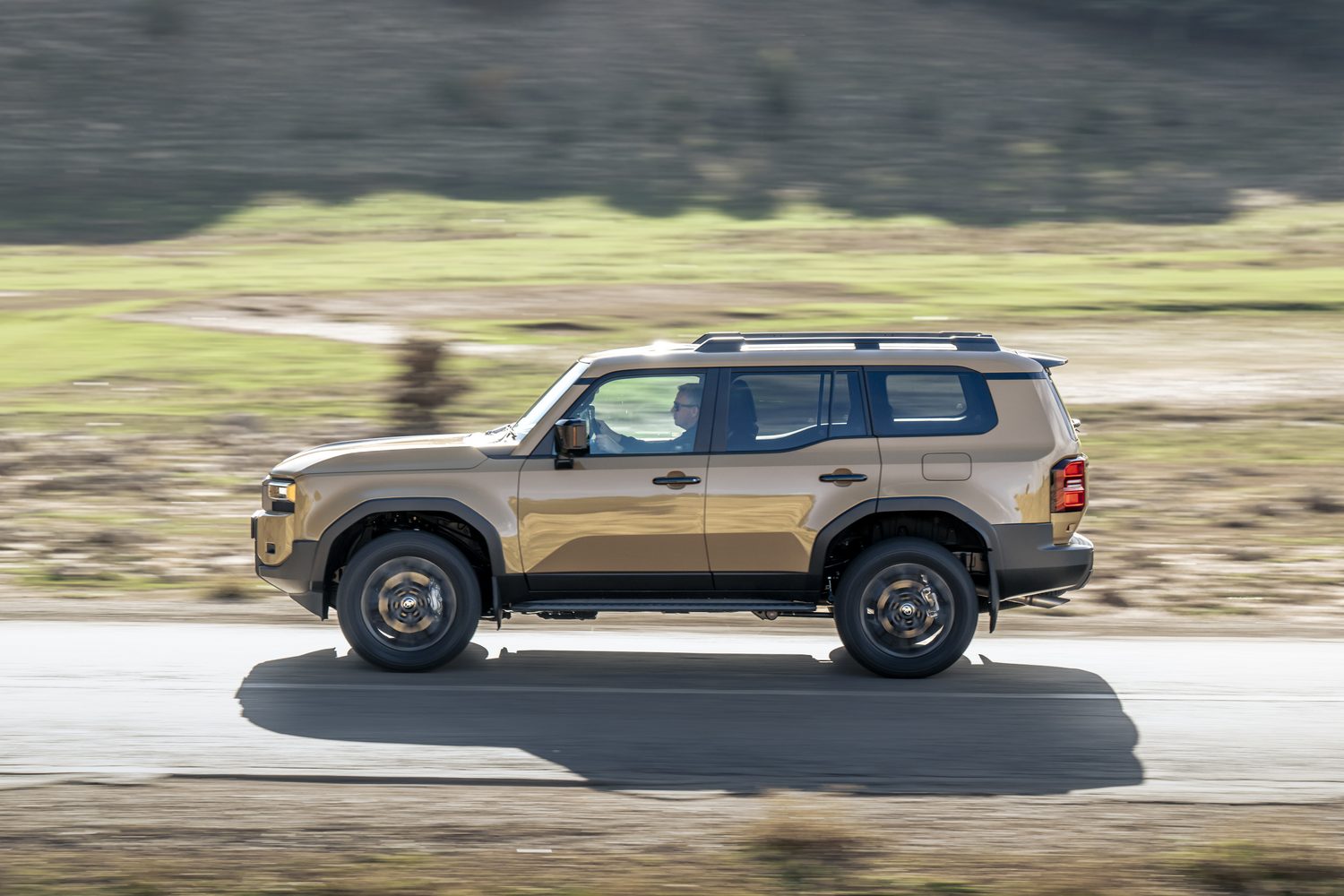To say that the Toyota Land Cruiser is a well-regarded vehicle, particularly in off-road circles, is an understatement. It has been a part of the Toyota range since 1951, starting out as the BJ Series, while the Land Cruiser name has been in use since 1954. Over time, the Land Cruiser family has been divided into three branches: Light Duty, Heavy Duty and Station Wagon. The latter is the type we commonly see on our roads, appearing in tax-friendly commercial form for business users in more recent years.

Toyota expects that trend to continue with the latest generation of Land Cruiser, the “250 series”, which will only come in the one body style seen here - there will no longer be a two-door, short-wheelbase option. Our first experience of the new Land Cruiser involved on- and off-road driving in Morocco in the five-seat passenger model, though when it arrives in Ireland, it will come exclusively in seven-seat guise alongside the two-seat commercial variant.
How big is the Toyota Land Cruiser?
The Toyota Land Cruiser measures 4,925mm long and is 2,115mm wide if you include the mirrors. Without them, it would be 1,980mm wide. Opt for the 18-inch wheels, and the Land Cruiser stands 1,925mm tall, while the 20-inch wheels add a further 10mm to the overall height. Its boxier exterior design creates more of a visual impact than its curvy predecessor’s, but in reality, there is little difference in overall size.

What’s it like inside the Toyota Land Cruiser?
The design of the Land Cruiser’s cabin reflects the angular exterior style. Ingress is relatively easy, and the electrically adjustable front seats have support in all the right places. The dashboard layout and the centre console arrangement are about functionality rather than aesthetics.
It’s pleasing to see that the steering wheel is totally round, and the simple three-spoke design is chunky, with many large buttons on the left and right spokes. Behind the wheel is a 12.3-inch colour digital instrument panel that allows a certain degree of personalisation. Next to this in the same panel, albeit at a slightly higher position, is the second 12.3-inch display, a touchscreen for the infotainment.
Below this is a pair of central air vents and the controls for the climate system. The broad centre console is home to a chunky drive selector (all Land Cruisers now come with an automatic transmission) and controls for the differential settings, drive modes, associated driver assistance and terrain controls. All of the buttons and switchgear have a typical Toyota feel whereby you get the sense of durability and the likelihood that in ten years every switch will still work like the day it left the factory.

The driving position is commanding and provides a good field of view outwards. You sit closer to the rather upright windscreen than you would in a typical SUV, and though you’re close to the A-pillar, it is kept reasonably thin so as not to block visibility. The driver’s seat also has a manual extending cushion that provides 50mm of thigh support. Rear passenger space is also adequate for this size of vehicle, although it’s important to note that we only had the opportunity to drive the five-seat configuration. The passenger version of the Land Cruiser in Ireland will be offered exclusively in seven-seat guise.
The Toyota Land Cruiser’s on-board technology
Reflective of the Land Cruiser’s modern image, Toyota hasn’t been shy about ensuring its flagship SUV is up to scratch on the technology front. We’ve already mentioned the dual-12.3-inch digital display setup, and this is supplemented by a 10-inch colour head-up display. There is a wireless phone charger and a total of six USB-C charge ports throughout the cabin, with two per seating row. A camera-based system with a digital display is integrated into the rear-view mirror, too. We also like that Toyota includes a cooled compartment in the centre console, which is ideal for keeping drinks cold.

The standard equipment isn’t as generous on the N1 Commercial version of the Land Cruiser. Differences include smaller displays inside, with a seven-inch digital instrument screen and only a nine-inch touchscreen, though the latter still includes wireless Android Auto and Apple CarPlay. The N1 also forgoes the digital rear-view mirror and upgraded, 14-speaker JBL sound system, which is standard on the passenger version.
Driving the Toyota Land Cruiser
There are plenty of obvious changes to the Land Cruiser, but one of the most significant takes place under the skin. Toyota uses its “GA-F” platform already seeing service in the larger Land Cruiser 300 that sells in other markets outside Europe. While it retains a body-on-frame construction, the new platform uses more advanced production techniques, including 84 additional short-pitch weld points around the doors, rocker edges and structural adhesive to enhance rigidity where sheet metal parts meet.
Toyota says that the frame’s torsional rigidity is up by 50 per cent, while a combined rise of 30 per cent overall should result in better on-road performance. That’s immediately obvious when driving this latest generation Land Cruiser, as it feels much more composed and refined.

The engine is not entirely new but a reworked upgrade of the 2.8-litre turbodiesel that powered the previous generation. Changes include a new turbocharger that, while smaller than its predecessor, works more efficiently and is more responsive. Aside from sounding quite gruff when started from cold, once up to temperature, it does a decent job of pulling the Land Cruiser along, as it generates its 500Nm peak torque output from 1,600rpm (through to 2,800rpm). It is reasonably quick to pick up on throttle inputs, and the eight-speed automatic gearbox also contributes to this impression.
When ambling along at a steady pace, the Toyota is quite civilised, and its commanding driving position is superior to almost all other SUVs out there. It can’t replicate the plush, supreme ride you’ll find in a Range Rover or the current Defender, but this is much more geared towards being a workhorse rather than a luxury item. There is the argument that those rivals are also very capable off-road, and indeed they are, but the Land Cruiser is cut from a different cloth.
Land Cruiser is equipped with an electric power steering setup for the first time, in the name of efficiency. There’s more accuracy and feedback on what the front axle is doing, too, though the suspension has also been reworked to enhance how the Land Cruiser drives. Toyota also equips the passenger model with a Stabiliser Disconnect Mechanism (SDM), which is a switchable anti-roll bar. This new setup contributes to a more comfortable drive on the road while also improving off-road ability when it’s disconnected, as it allows for increased suspension travel and wheel articulation for improved ground contact for each wheel.

A new independent double-wishbone arrangement up front has a longer stroke to suit more positive roadholding without sacrificing off-road capabilities. A four-link rigid axle on the rear has received revisions to bring a smoother and more linear performance, with an anti-roll bar construction that is lighter yet more rigid, too. All that’s not to say that it isn’t a comfortable ride - it can be - but there’s still a busyness at times to how it drives down the road, and its overall power output of a mere 205hp tells you more about how it wants to be driven rather than how it should be driven.
When you veer away from the road and get onto trickier trails, the Land Cruiser begins to show its true abilities. Our car was wearing 20-inch alloy wheels shod with Dunlop Grand Trek all-terrain tyres, and despite some torrential rain the previous day that thoroughly soaked the trails, nothing stopped progress. Suitable tyres do play a part when going off road, but the permanent all-wheel-drive transmission is a massive help. The Land Cruiser is equipped with a revised central differential for better fuel economy and quieter performance, while the electronic locking rear differential has also been strengthened for greater reliability. The differential lock is now a solenoid type that responds 85 per cent faster according to Toyota.

There was little question of how much grip and traction was available on fresh uphill tracks, even when still in the “H4” setting. Switching to low range is simple; every transmission control is on the centre console, including the Downhill Assist Control (DAC) and Crawl Control, which provides five speed settings and avoids wheel spin and wheel locking in off-road and downhill settings. Even the least experienced drivers in off-road conditions will feel confident, such is the breadth of capability the Toyota demonstrates in these environments. Choosing the different assistance systems is an intuitive task, something Toyota’s engineers - with help from factory rally drivers - were keen to provide.
With approach and departure angles of 32 and 17 degrees respectively - and with 215 millimetres of ground clearance - there was surprisingly little in the way of audible points of contact between the underbody and ground. Using the different assistance systems makes light work of even the steepest of trails that you’re likely to encounter in the real world, so much so that you could almost be lulled into trying so without them. Away from the arranged off-road sections, we tackled more extreme mountainous trails later on, which required more driver input than the use of the systems, and it was here that the Land Cruiser truly proved its worth as a vehicle capable of tackling virtually anything that’s thrown at it and doing so in a way that makes it seem impossibly easy.

How practical is the Toyota Land Cruiser?
As you would hope from the size of the vehicle, the Land Cruiser is relatively practical. For starters, it’s possible to open just the rear window by pressing a discreet button on the bottom left of the glass, making it handy for throwing in an item if you already have the boot packed with things. A top-hinged, powered boot lid is standard on all versions coming to Ireland. It opens to reveal a very wide aperture, meaning that even the bulkiest of items shouldn’t pose much difficulty when loading.

Passenger versions of the Land Cruiser in Ireland will come only in the seven-seat configuration. That provides 130 litres of boot space when the third row of seats is in use, and when they’re folded the cargo capacity rises to 556 litres. When both rear seat rows are folded, 1,053 litres of cargo volume is available. For reference, the five-seat version we’re driving here has a boot capacity of 742 litres when all seats are in use and up to 1,292 litres when the rear seats are folded down.
How safe is the Toyota Land Cruiser?
There are numerous safety systems and driver assistance technologies in the Land Cruiser, many of which fall under the Toyota Safety Sense umbrella. This includes pre-collision systems that can detect other vehicles, cyclists and motorcycles during daytime and pedestrians during day and night. The inclusion of electric power steering works in concert with the pre-collision system (PCS). When it detects a hazard, it can provide additional steering support when the driver reacts while also applying gentle braking as needs be.
An Emergency Driving Stop System can detect if a driver has become unresponsive. The system can detect a lack of driver input and issue an alert. If there is still no response it will bring the vehicle to a stop and activate the hazard warning lights.

Along with a full accompaniment of airbags inside, the Land Cruiser has all of the latest mandated safety features such as Road Sign Assist, a camera that monitors the driver’s face to detect for distraction or drowsiness and blind-spot monitoring that also warns if an occupant tries to open a door when there is a vehicle or cyclist approaching from behind.
The reasons you’d buy a Toyota Land Cruiser
There are numerous reasons why you’d consider buying a Toyota Land Cruiser. For many, the simple fact that it is available as an N1 commercial from the factory and the subsequent cost efficiencies of purchasing and running one through a company or business will be reason alone for it to be on some buyers’ consideration list.
There’s also the strong reputation Toyota enjoys with the Land Cruiser for durability and reliability, especially for those in rural and farming backgrounds where the vehicle is as much a tool as a form of transport. Another major plus in the Land Cruiser’s repertoire is that it is rated to tow up to 3,500kg and is fitted with permanent all-wheel drive as standard. From 2025, a 48-volt, mild-hybrid diesel will join the line up and is expected to bring slight improvements to fuel economy and emissions.

How much does the Toyota Land Cruiser cost in Ireland?
Irish pricing for the Toyota Land Cruiser starts at €140,830 for the passenger version. There aren’t many options to add, but metallic paint will cost a further €1,650, while pearlescent paint adds €2,045. One accessory likely to be a popular option is the tow bar, which is a dealer-fit option.
Pricing for the N1 Land Cruiser Commercial is expected to start at €69,990, including VAT.
What are the running costs of the Toyota Land Cruiser like?
The official fuel consumption figures for the Toyota Land Cruiser are 10.5-10.7 litres per 100 kilometres. During our time driving the car, which covered a diverse mix of on-road and off-road driving, it used 11.9 litres per 100 kilometres, which is reasonable given the conditions. Obviously, if you’re doing a lot of towing, that consumption figure will increase depending on the weight being pulled.

The one big downside to running the Toyota Land Cruiser in passenger form is that due to its emissions, it falls under the highest motor tax band, which has an annual cost of €2,400.
Toyota Ireland provides a 100,000-kilometre or three-year warranty with the Land Cruiser. It also includes a three-year unlimited mileage warranty cover for surface rust and paintwork and a twelve-year unlimited mileage warranty for corrosion perforation. There is also a Toyota Relax extended warranty package that is linked to authorised dealer-based servicing. This plan extends the warranty cover by 12 months or 15,000 kilometres, and this can roll over with each subsequent service for up to 10 years or 185,000 kilometres.
Ask us anything about the Toyota Land Cruiser
If there are any details relating to the Toyota Land Cruiser that we’ve not covered, or you’d like advice in choosing between it and other vehicles, you can avail of our (completely free) expert advice service via the Ask Us Anything page.













































